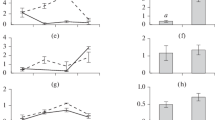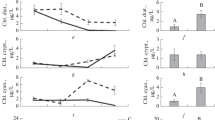Abstract
One of the central paradigms of ecology is that only about 10% of organic carbon production of one trophic level is incorporated into new biomass of organisms of the next trophic level. Many of energy-yielding compounds of carbon are designated as ‘essential’, because they cannot be synthesized de novo by consumers and must be obtained with food, while they play important structural and regulatory functions. The question arises: are the essential compounds transferred through trophic chains with the same efficiency as bulk carbon? To answer this question, we measured gross primary production of phytoplankton and secondary production of zooplankton and content of organic carbon and essential polyunsaturated fatty acids of ω-3 family with 18–22 carbon atoms (PUFA) in the biomass of phytoplankton and zooplankton in a small eutrophic reservoir during two summers. Transfer efficiency between the two trophic levels, phytoplankton (producers) and zooplankton (consumers), was calculated as ratio of the primary production versus the secondary (zooplankton) production for both carbon and PUFA. We found that the essential PUFA were transferred from the producers to the primary consumers with about twice higher efficiency than bulk carbon. In contrast, polyunsaturated fatty acids with 16 carbon atoms, which are synthesized exclusively by phytoplankton, but are not essential for animals, had significantly lower transfer efficiency than both bulk carbon, and essential PUFA. Thus, the trophic pyramid concept, which implicitly implies that all the energy-yielding compounds of carbon are transferred from one trophic level to the next with the same efficiency of about on average 10%, should be specified for different carbon compounds.





Similar content being viewed by others
References
Ahlgren G, Gustafsson IB, Boberg M (1992) Fatty acid content and chemical composition of freshwater microalgae. J Phycol 28:37–50
Ahlgren G, Goedkoop W, Markensten H, Sonesten L, Boberg M (1997) Seasonal variations in food quality for pelagic and benthic invertebrates in lake Erken—the role of fatty acids. Freshw Biol 38:555–570
Alimov AF (1989) An introduction to production hydrobiology. Gidrometeoizdat, Leningrad
Aoki I (2006) Ecological pyramid of dissipation function and entropy production in aquatic ecosystems. Ecol Complex 3:104–108
Arts MT, Ackman RG, Holub BJ (2001) ‘‘Essential fatty acids’’ in aquatic ecosystems: a crucial link between diet and human health and evolution. Can J Fish Aquat Sci 58:122–137
Balushkina EV, Winberg GG (1979) Relation between mass and body size of plankton animals. In: Winberg GG (ed) General backgrounds for study of aquatic ecosystems. Nauka, Leningrad, pp 169–172
Bell MV, Tocher DR (2009) Biosynthesis of polyunsaturated fatty acids in aquatic ecosystems: general pathways and new directions. In: Arts MT, Kainz M, Brett MT (eds) Lipids in aquatic ecosystems. Springer, New York, pp 211–236
Brett MT, Muller-Navarra DC, Ballantyne AP, Ravet JL, Goldman CR (2006) Daphnia fatty acid compostion reflects that of their diet. Limnol Oceanogr 51:2428–2437
Clesceri CE, Greenberg AE, Trussell RR (1989) Standard methods (for the examination of water and wastewater). American Public Health Association, American Water Works Association, Water Pollution Control Federation, Washington
Cohen Z, Norman HA, Heimer YM (1995) Microalgae as a source of ω-3 fatty acids. In: Simopoulos AP (ed) Plants in human nutrition. World review of nutrition and dietetics, vol 77. Karger, Basel, pp 1–31
Copeman LA, Parrish CC, Brown JA, Harel M (2002) Effects of docosahexaenoic, eicosapentaenoic, and arachidonic acids on the early growth, survival, lipid composition and pigmentation of yellowtail flounder (Limanda ferruginea): a live food enrichment experiment. Aquaculture 210:285–304
DeMott WR, Gulati RD (1999) Phosphorus limitation in Daphnia: evidence from a long-term study of three hypereutrophic Dutch lakes. Limnol Oceanogr 44:1557–1564
Domergue F, Spiekermann P, Lerchl J, Beckmann C, Kilian O, Kroth PG, Boland W, Zahringer U, Heinz E (2003) New insights into Phaeodactylum tricornutum fatty acid metabolism. Cloning and functional characterization of plastidial and microsomal Δ12-fatty acid desaturases. Plant Physiol 131:1648–1660
Gaevsky NA, Kolmakov VI, Popelnitsky VA, Gold VM, Dubovskaya OP (2000) Evaluation of the effect of light intensity on the measurement of the photosynthetic rate in plankton microalgae by the chlorophyll fluorescence method. Russ J Plant Physiol 47:820–825
Gaevsky NA, Zotina TA, Gorbaneva TB (2002) Vertical structure and photosynthetic activity of Lake Shira phytoplankton. Aquat Ecol 36:165–178
Gaevsky NA, Kolmakov VI, Anishchenko OV, Gorbaneva TB (2005) Using DCMU-fluorescence method for identification of dominating phytoplankton groups. J Appl Phycol 17:483–494
Garg ML, Wood LG, Singh H, Moughan PJ (2006) Means of delivering recommended levels of long chain n-3 polyunsaturated fatty acids in human diets. J Food Sci 71:R66–R71
Gerster H (1998) Can adults adequately convert α-linoleic acid (18:3n-3) to eicosapentaenoic acid (20:5n-3) and docosahexaenoic acid (22:6n-3)? Int J Vitamin Nutr Res 68:159–173
Gladyshev MI, Emelianova AY, Kalachova GS, Zotina TA, Gaevsky NA, Zhilenkov MD (2000) Gut content analysis of Gammarus lacustris from a Siberian lake using biochemical and biophysical methods. Hydrobiologia 431:155–163
Gladyshev MI, Sushchik NN, Kolmakova A, Kalachova GS, Kravchuk ES, Ivanova EA, Makhutova ON (2007) Seasonal correlations of elemental and ω-3 PUFA composition of seston and dominant phytoplankton species in a eutrophic Siberian reservoir. Aquat Ecol 41:9–23
Gladyshev MI, Arts MT, Sushchik NN (2009) Preliminary estimates of the export of omega-3 highly unsaturated fatty acids (EPA + DHA) from aquatic to terrestrial ecosystems. In: Arts MT, Kainz M, Brett MT (eds) Lipids in aquatic ecosystems. Springer, New York, pp 179–209
Gladyshev MI, Krylov AV, Sushchik NN, Malin MI, Makhutova ON, Chalova IV, Kalacheva GS (2010a) Transfer of essential polyunsaturated fatty acids from an aquatic to terrestrial ecosystem through the fish–bird trophic pair. Doklady Biol Sci 431:121–123
Gladyshev MI, Sushchik NN, Makhutova ON, Dubovskaya OP, Kravchuk ES, Kalachova GS, Khromechek EB (2010b) Correlations between fatty acid composition of seston and zooplankton and effects of environmental parameters in a eutrophic Siberian reservoir. Limnologica 40:343–357
Goulden CE, Place AR (1990) Fatty acid synthesis and accumulation rates in daphniids. J Exp Zool 256:168–178
Gutseit K, Berglund O, Graneli W (2007) Essential fatty acids and phosphorus in seston from lakes with contrasting terrestrial dissolved organic carbon content. Freshw Biol 52:28–38
Harwood JL (1996) Recent advances in the biosynthesis of plant fatty acids. Biochim Biophys Acta 1301:7–56
Heinz E (1993) Biosynthesis of polyunsaturated fatty acids. In: Moore TS (ed) Lipid metabolism in plants. CRC, Boca Raton, pp 34–89
Hessen DO, Andersen T, Brettum P, Faafeng BA (2003) Phytoplankton contribution to sestonic mass and elemental ratios in lakes: implications for zooplankton nutrition. Limnol Oceanogr 48:1289–1296
Ishimaru T, Mimuro M, Fujita Y (1985) Estimation of phytoplankton photosynthesis using a fluorescence induction technique. J Plankton Res 7:679–689
Kainz M, Arts MT, Mazumder A (2004) Essential fatty acids in the planktonic food web and their ecological role for higher trophic levels. Limnol Oceanogr 49:1784–1793
Kainz M, Perga M-E, Arts MT, Mazumder A (2009) Essential fatty acid concentrations of different seston sizes and zooplankton: a field study of monomictic coastal lakes. J Plankton Res 31:635–645
Kolmakov VI, Gaevsky NA, Gold VM, Popelnitsky VA (2005) Estimation of primary production individual taxonomic groups of phytoplankton on the basis of a fluorescence method. Biol Inland Waters 4:13–18
Lacroix G, Lescher-Moutoue F, Bertolo A (1999) Biomass and production of plankton in shallow and deep lakes: are there general patterns? Ann Limnol 35:111–122
Lands WEM (2009) Human life: caught in the food web. In: Arts MT, Kainz M, Brett MT (eds) Lipids in aquatic ecosystems. Springer, New York, pp 327–354
Lehninger AL, Nelson DL, Cox MM (1993) Principles of biochemistry, 2nd edn. Worth, New York
Leonard AE, Pereira SL, Sprecher H, Huang Y-S (2004) Elongation of long-chain fatty acids. Prog Lipid Res 43:36–54
Lindeman RL (1942) The trophic–dynamic aspect of ecology. Ecology 23:399–418
Maazouzi C, Masson G, Izquierdo MS, Pihan J-C (2008) Midsummer heat wave effects on lacustrine plankton: variation of assemblage structure and fatty acid composition. J Thermal Biol 33:287–296
Makhutova ON, Kalachova GS, Gladyshev MI (2003) A comparison of the fatty acid composition of Gammarus lacustris and its food sources from a freshwater reservoir, Bugach, and the saline Lake Shira in Siberia, Russia. Aquat Ecol 37:159–167
Muller-Navarra DC, Brett MT, Liston AM, Goldman CR (2000) A highly unsaturated fatty acid predicts carbon transfer between primary producers and consumers. Nature 403:74–77
Muller-Navarra DC, Brett MT, Park S, Chandra S, Ballantyne AP, Zorita E, Goldman CR (2004) Unsaturated fatty acid content in seston and tropho–dynamic coupling in lakes. Nature 427:69–72
Oquist G, Hagstrom A, Alm P, Samuelsson G, Richardson K (1982) Chlorophyll a fluorescence, an alternative method for estimating primary production. Mar Biol 68:71–75
Pauly D, Christensen V (1995) Primary production required to sustain global fisheries. Nature 374:255–257
Plourde M, Cunnane SC (2007) Extremely limited synthesis of long chain polyunsaturates in adults: implications for their dietary essentiality and use as supplements. Appl Physiol Nutr Metabol 32:619–634
Raffaelli D (2002) From Elton to mathematics and back again. Science 296:1035–1036
Rao CRN (1984) Photosynthetically active components of global solar radiation: measurements and model computations. Meteorol Atmos Phys 34:353–364
Rossi S, Sabates A, Latasa M, Reyes E (2006) Lipid biomarkers and trophic linkages between phytoplankton, zooplankton and anchovy (Engraulis encrasicolus) larvae in the NW Mediterranean. J Plankton Res 28:551–562
Sargent J, Bell G, McEvoy L, Tocher D, Estevez A (1999) Recent developments in the essential fatty acid nutrition of fish. Aquaculture 177:191–199
Schulz M, Koschel R, Reese C, Mehner T (2004) Pelagic trophic transfer efficiency in an oligotrophic, dimictic deep lake (Lake Stechlin, Germany) and its relation to fisheries yield. Limnologica 34:264–273
Smyntek PM, Teece MA, Schulz KL, Storch AJ (2008) Taxonomic differences in the essential fatty acid composition of groups of freshwater zooplankton relate to reproductive demands and generation time. Freshw Biol 53:1768–1782
Stockwell JD, Johannsson OE (1997) Temperature-dependent allometric models to estimate zooplankton production in temperate freshwater lakes. Can J Fish Aquat Sci 54:2350–2360
Sushchik NN, Gladyshev MI, Kalachova GS, Kravchuk ES, Dubovskaya OP, Ivanova EA (2003a) Particulate fatty acids in two small Siberian reservoirs dominated by different groups of phytoplankton. Freshw Biol 48:394–403
Sushchik NN, Gladyshev MI, Moskvichova AV, Makhutova ON, Kalachova GS (2003b) Comparison of fatty acid composition in major lipid classes of the dominant benthic invertebrates of the Yenisei River. Comp Biochem Phys B 134:111–122
Sushchik NN, Gladyshev MI, Makhutova ON, Kalachova GS, Kravchuk ES, Ivanova EA (2004) Associating particulate essential fatty acids of the ω-3 family with phytoplankton species composition in a Siberian reservoir. Freshw Biol 49:1206–1219
Taipale S, Kankaala P, Hamalainen H, Jones RI (2009) Seasonal shifts in the diet of lake zooplankton revealed by phospholipid fatty acid analysis. Freshw Biol 54:90–104
Tocher DR, Leaver MJ, Hodson PA (1998) Recent advances in the biochemistry and molecular biology of fatty acyl desaturase. Prog Lipid Res 37:73–117
Vizcaino-Ochoa V, Lazo JP, Baron-Sevilla B, Drawbridge MA (2010) The effect of dietary docosahexaenoic acid (DHA) on growth, survival and pigmentation of California halibut Paralichthys californicus larvae (Ayres, 1810). Aquaculture 302:28–234
Wacker A, Von Elert E (2001) Polyunsaturated fatty acids: evidence for non-substitutable biochemical resources in Daphnia galeata. Ecology 82:2507–2520
Acknowledgments
The work was supported by “Thematic plans program” from the Ministry of Education and Sciences of Russian Federation (Theme B-4 of Siberian Federal University) and by a joint grant of the American Civilian Research and Development Foundation and the Ministry of Education and Sciences of Russian Federation (CRDF, project No. REC-002). We are grateful to handling editor, R.O.Hall, and two anonymous reviewers for their very helpful comments to improve the manuscript.
Author information
Authors and Affiliations
Corresponding author
Additional information
Communicated by Robert Hall.
Rights and permissions
About this article
Cite this article
Gladyshev, M.I., Sushchik, N.N., Anishchenko, O.V. et al. Efficiency of transfer of essential polyunsaturated fatty acids versus organic carbon from producers to consumers in a eutrophic reservoir. Oecologia 165, 521–531 (2011). https://doi.org/10.1007/s00442-010-1843-6
Received:
Accepted:
Published:
Issue Date:
DOI: https://doi.org/10.1007/s00442-010-1843-6




